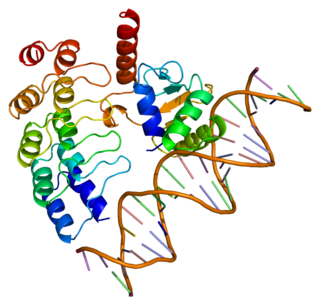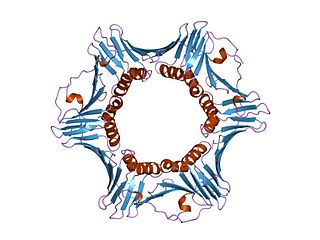Replication factor C subunit 1 is a protein that in humans is encoded by the RFC1 gene. [5] [6]
Replication factor C subunit 1 is a protein that in humans is encoded by the RFC1 gene. [5] [6]
The protein encoded by this gene is the large subunit of replication factor C, which is a five subunit DNA polymerase accessory protein. Replication factor C is a DNA-dependent ATPase that is required for eukaryotic DNA replication and repair. The protein acts as an activator of DNA polymerases, binds to the 3' end of primers, and promotes coordinated synthesis of both strands. It also may have a role in telomere stability. [6]
RFC1 has been shown to interact with:
Biallelic intronic repeat expansions (a series of repeating nucleotide sequences) in the replication factor C subunit 1 (RFC1) gene causes cerebellar ataxia, neuropathy and vestibular areflexia syndrome (CANVAS). [17] Within the poly(A) tail of an AluSx3 element in RFC1, there are eleven repeats of the pentanucleotide "AAAAG". Repeat expansion and polymorphic configuration are observed in part of the population, with increased number of repeats associated to alternative "AAAGG", "AAGGG" and "ACAGG" pentanucleotides. [18] In particular, biallelic "AAGGG" and "ACAGG" repeat expansion have disproportionately been observed in patients with CANVAS. Biallelic "AAGGG" repeat expansion is also reported in a high number of sporadic cases of late-onset ataxia, [17] isolate sensory neuropathy [19] [20] and, less frequently, isolate cerebellar ataxia. [21] Due to a diagnostic overlap with CANVAS, researchers have also investigated the presence of RFC1 expansions in pathologically confirmed multiple system atrophy (MSA) but found a similar alteration frequency (0.7%) to a healthy population, suggesting RFC1 does not have a role in this disease. [22]
Mutant biallelic intronic repeat expansions do not affect RFC1 expression in patient peripheral and brain tissue, suggesting no overt loss of function of this gene. [17]
In patients with the pathogenic RFC1 expansion, sensory neuropathy appears to be a predominant feature and patients may also present with symptoms such as cerebellar dysfunction, vestibular involvement and a dry spasmodic cough therefore, genetic testing is recommended in those with these symptoms. [23]
The replication factor C, or RFC, is a five-subunit protein complex that is required for DNA replication.

Proliferating cell nuclear antigen (PCNA) is a DNA clamp that acts as a processivity factor for DNA polymerase δ in eukaryotic cells and is essential for replication. PCNA is a homotrimer and achieves its processivity by encircling the DNA, where it acts as a scaffold to recruit proteins involved in DNA replication, DNA repair, chromatin remodeling and epigenetics.

A DNA clamp, also known as a sliding clamp, is a protein complex that serves as a processivity-promoting factor in DNA replication. As a critical component of the DNA polymerase III holoenzyme, the clamp protein binds DNA polymerase and prevents this enzyme from dissociating from the template DNA strand. The clamp-polymerase protein–protein interactions are stronger and more specific than the direct interactions between the polymerase and the template DNA strand; because one of the rate-limiting steps in the DNA synthesis reaction is the association of the polymerase with the DNA template, the presence of the sliding clamp dramatically increases the number of nucleotides that the polymerase can add to the growing strand per association event. The presence of the DNA clamp can increase the rate of DNA synthesis up to 1,000-fold compared with a nonprocessive polymerase.

Ku70 is a protein that, in humans, is encoded by the XRCC6 gene.

Cell cycle checkpoint control protein RAD9A is a protein that in humans is encoded by the RAD9A gene.Rad9 has been shown to induce G2 arrest in the cell cycle in response to DNA damage in yeast cells. Rad9 was originally found in budding yeast cells but a human homolog has also been found and studies have suggested that the molecular mechanisms of the S and G2 checkpoints are conserved in eukaryotes. Thus, what is found in yeast cells are likely to be similar in human cells.

Cullin-4A is a protein that in humans is encoded by the CUL4A gene. CUL4A belongs to the cullin family of ubiquitin ligase proteins and is highly homologous to the CUL4B protein. CUL4A regulates numerous key processes such as DNA repair, chromatin remodeling, spermatogenesis, haematopoiesis and the mitotic cell cycle. As a result, CUL4A has been implicated in several cancers and the pathogenesis of certain viruses including HIV. A component of a CUL4A complex, Cereblon, was discovered to be a major target of the teratogenic agent thalidomide.

GA-binding protein alpha chain is a protein that in humans is encoded by the GABPA gene.

Checkpoint protein HUS1 is a protein that in humans is encoded by the HUS1 gene.

Flap endonuclease 1 is an enzyme that in humans is encoded by the FEN1 gene.

Cyclin-O is a protein that in humans is encoded by the CCNO gene.

Replication factor C subunit 4 is a protein that in humans is encoded by the RFC4 gene.

Replication factor C subunit 2 is a protein that in humans is encoded by the RFC2 gene.

The gene polymerase delta 1 (POLD1) encodes the large, POLD1/p125, catalytic subunit of the DNA polymerase delta (Polδ) complex. The Polδ enzyme is responsible for synthesizing the lagging strand of DNA, and has also been implicated in some activities at the leading strand. The POLD1/p125 subunit encodes both DNA polymerizing and exonuclease domains, which provide the protein an important second function in proofreading to ensure replication accuracy during DNA synthesis, and in a number of types of replication-linked DNA repair following DNA damage.

Replication factor C subunit 3 is a protein that in humans is encoded by the RFC3 gene.

Replication factor C subunit 5 is a protein that in humans is encoded by the RFC5 gene.

Eukaryotic translation initiation factor 3 subunit D (eIF3d) is a protein that in humans is encoded by the EIF3D gene.

DNA polymerase delta subunit 3 is an enzyme that in humans is encoded by the POLD3 gene. It is a component of the DNA polymerase delta complex.

Chromosome transmission fidelity protein 18 homolog is a protein that in humans is encoded by the CHTF18 gene.

Origin recognition complex subunit 1 is a protein that in humans is encoded by the ORC1 gene. It is closely related to CDC6, and both are the same protein in archaea.

Replication protein A 32 kDa subunit is a protein that in humans is encoded by the RPA2 gene.